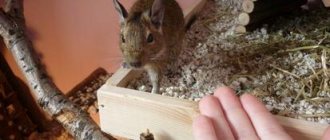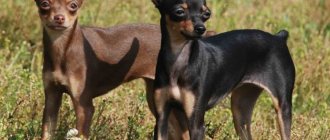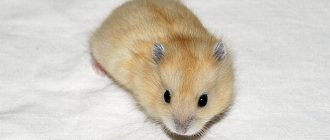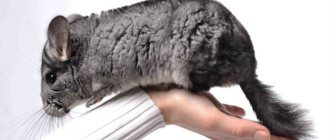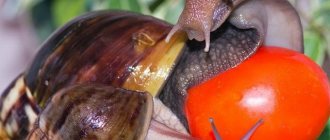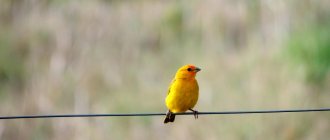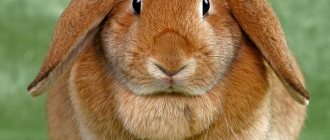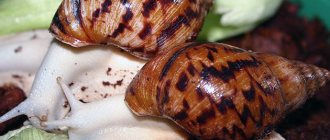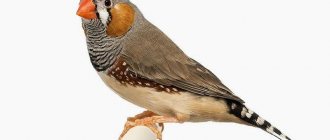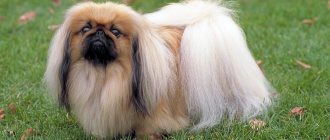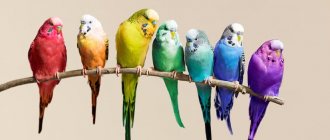12/28/2015 Category: Pets Author: Natalya Ivantsova
Degus are small animals that look like a jerboa. Along with other exotics, they are rapidly gaining popularity among those who want to have an unusual pet. These pets are very inquisitive, active and interesting. But before you place a degu at home, you need to know certain maintenance rules in order to ensure a long and happy life for them.
- To start or not to start - that is the question
pros
- Minuses
- Selection and equipment of the cage
- Food: what to eat and how often to feed
general information
Degus are cute, tame rodents that are easy to train.
Degu is a small South American rodent. Other common names for this animal include two: bush rat and Chilean squirrel. The animal is highly active with a relatively small size. An adult reaches up to 30 cm in length, while weighing only 200-300 g. In nature, degus come in only two colors: brown-yellow or chestnut-gray.
The fur of the Chilean squirrel is hard and dense. Like most rodents, these animals have 8 pairs of teeth that grow throughout their lives. Degus can adapt to living at home if they are provided with the appropriate conditions. With proper care and nutrition, such a pet can live up to 6-8 years.
How long do Chilean squirrels live in the wild?
Degus live in the center and north of South America: Brazil, Chile. In the wild they live on average 5-7 years. There are also long-livers who exist for 10-15 years , but this is rather the exception than the rule.
Degus are very active animals; they move long distances in search of food, and for housing they dig huge holes from which they build tunnels. They live in packs, are very sociable, and cannot stand being alone.
What determines the lifespan of a degu in nature?
In natural habitats, there are many factors that influence the lifespan of animals.
- Natural selection. This is the most significant factor. Some individuals do not survive even one day, since the female immediately after birth eats the non-viable cubs. Part of the litter may subsequently die, and an even smaller proportion of animals survive up to two months.
- Natural conditions. They can also be classified in the first category, but they should be separated into a separate one. Both a weak individual and a healthy one can die under unfavorable natural conditions. Of course, sick and weak degus die faster, but during floods or fires, strong, healthy animals also suffer.
- Nutrition. Squirrels can search for food for themselves and their family for a long time and at great distances from home. However, frequent fires or droughts deprive these animals of a normal diet, which greatly affects their health and life expectancy.
- Competition. Degus live in packs; they cannot be called friendly, since clashes often occur among relatives, but they rarely come to the point of killing their own kind. But predators are happy to feast on small rodents. Chilean squirrels have quite a lot of enemies in their natural environment, and they often have to run away from a predator to save their lives.
Statistics show that in nature, not even every hundredth individual is able to live up to two years. So the existence of degus in captivity is more likely a salvation for them than a punishment.
To start or not to start - that is the question
Smart and inquisitive degus make excellent pets.
Keeping an exotic pet at home is a responsible decision. Before you dare and buy a degu, you need to clearly decide whether this animal is right for you or not. Let's look at the advantages and disadvantages of keeping a Chilean squirrel in the house.
pros
- Compared to large domestic animals, rodents consume much less food.
- Degus take up little space in the apartment; you just need to decide on the location of the cage.
- These animals are very inquisitive, active and sociable. When raised correctly, they become attached to their owner.
- Degus do not have a specific odor and do not require special hygienic care.
- Rodents are diurnal, and the owner will be able to sleep peacefully at night, without extraneous noise.
- Since the Chilean squirrel is a steppe animal, it consumes little liquid and produces little excretion. You will not have to clean the cage as often as when keeping other rodents.
- Degu is a long-liver. Unlike rats, hamsters and chinchillas, they live up to 8 years.
- The female's pregnancy lasts 3 months, and she can produce up to 3 litters per year. Considering the small number of cubs, there are no problems with the sale of offspring.
Minuses
- The degu bathes in sand, which will spill outside the cage, so the area around it will need to be cleaned regularly.
- Taming a rodent is not as easy as taming a cat or dog. But with due attention and patience it is possible.
- Degus love to test different objects: cables, furniture upholstery, shoes. When letting the animal out for a walk, you will need to control the movements and actions of your pet so that it does not cause damage.
Rodent diet
Degus are completely vegetarian, their main diet is roots, herbs and plant seeds. Ready-made food is sold in pet stores, but if desired, you can make it yourself - grains, crackers, oatmeal and dried peas. There should always be hay in a separate feeder; add it as needed. There should always be hay.
You can also feed him fresh vegetables and fruits every day, 50 grams, always at room temperature.
You should not give sweet fruits and foods with sugar - degus do not break down sugar, they will inevitably develop diabetes!
Be sure to exclude from the diet:
- Dairy and fermented milk products;
- Overripe or underripe fruits and vegetables;
- Food from our table;
- Meat and fish.
You should feed him several times a day, in small portions, so that the food is better absorbed. Keep an eye on the sippy cup; there should always be fresh water in it, change it daily.
How to choose the right one
So, you have carefully studied all the pros and cons of keeping a degu in an apartment and are ready to buy. What features should be considered when purchasing a pet? Let's consider the main ones:
- The most important aspect is the age of the animal. The best time to take a degu is 1.5-2 months. Until this time, the cubs feed on mother's milk, which cannot be replaced by any food. At the same time, babies develop strong immunity, habits and survival skills, which are passed on to adults.
- Pay attention to the conditions in which the parents are kept: whether the cage is clean, how well-groomed and healthy the animals are.
- Take an interest in the diet of adult degus from whom you want to take the baby. If owners feed their pets incorrectly, the risk of developing diabetes in small rodents increases dramatically.
- Look at your parents' behavior. Animals kept in good conditions are not shy and will not run away. On the contrary, they will study new guests with interest.
- A healthy degu baby has smooth and even fur, without bald spots. The eyes are shiny, dry and without any discharge. The absence of a tassel on the tail is not a sign of a sick degu, but only a feature of its appearance.
- The parent male should live in a separate cage, as he can cover females that have reached the age of 1.5 months. This means that you risk taking home an already pregnant little degu. If rodents are given away after 2 months, then female degus should be in the same home with their mother, and boys with their father. Young males who have reached this age can also cause early fertilization. The result is pregnancy and inbreeding at the same time.
Health
Proper care and good conditions in which Chilean squirrels are kept are the key to a long and happy life. A healthy animal is easy to distinguish from a sick one. He has a good appetite, he is cheerful, active and “tests his teeth” with the whole world around him with great interest. Sometimes literally. Of the serious diseases, degus are most susceptible to diabetes, which occurs as a result of poor nutrition and obesity. Females especially often suffer from it after the birth of babies. Therefore, as a preventive measure, it is necessary to give a certain level of stress to the young mother, and, of course, feed her correctly.
The normal weight of an adult degu is 300 grams. If it is taller, and visually, the belly protrudes strongly, then this animal has a high risk of serious illness. Degus are very clean animals; they do not cause problems to their owners. However, providing good conditions for keeping them will require certain material costs.
Video
Content Features
Chilean squirrels are not the most demanding in terms of maintenance. However, certain features still exist. To ensure your pet has a long and enjoyable life at home, it is necessary to pay attention to proper nutrition, hygiene conditions and socialization of degus.
Selection and equipment of the cage
Option to equip a cage for several degus
Cage equipment for a comfortable degu life
Degus love spacious cages. Do not forget that this animal is a steppe animal. Therefore, choose an enclosure whose size is at least 120x50x100 cm. It should have enough space for research, and therefore a small-sized cage with primitive equipment cannot be used.
Important! Please note that degus rarely live alone. They need to be kept in pairs, so for comfortable living of several animals you will need a more spacious home.
Make sure that each degu has the following items inside its enclosure:
- Your own house, as well as several “shelters” in the form of burrows (you can use old clay pots for this).
- Also, the cage should have shelves installed at different levels. They must be carefully attached to the walls so that the animal does not get injured during active movements.
- Bowls for food (several pieces are required).
- Drinking bowls for rodents.
- Bedding (for degus you need to use white paper, and pour a layer of sawdust or compressed corn cobs on top of it).
- Running wheel.
- Stone or strong block (for grinding teeth).
- Sand bath for bathing.
The cage must be located away from direct sunlight and drafts. If you are too sensitive to sounds, then place the enclosure away from the bed so that rodents do not disturb your sleep.
Important! Having brought home a small degu, under no circumstances rush to take it out and transplant it to a new home. Leave the animal in a temporary carrier next to the cage for the day. Otherwise, the animal will experience stress and may never get used to being handled.
After the little degu is transplanted into a new home, take some of the old bedding and put it in the cage. This way the pet will be calmer.
Concern for safety
The life of a degu in an apartment is full of dangers from which you need to protect
Due to their physiological characteristics and origin, all rodents are susceptible and shy. Therefore, special attention should be paid to the safety of the little degu. To ensure your pet's comfort, the following points must be considered:
- Degus are sensitive to heat, high humidity, cold and noise, so keep the cage away from a window. The ideal temperature regime is +24°С…+26°С.
- In natural conditions, the main threat to animals is birds of prey, so rodents are afraid of an “attack from the sky” on an instinctive level. They will not feel comfortable if the cage is too low and the person leans into it every day. It is best to position the enclosure so that its central part is at eye level with the owner.
- Smoking is prohibited in the room where degus are kept. For the same reason, it is not recommended to keep animals in the kitchen, since there are many sources of pungent odors for the rodent.
- Do not play loud music or TV near your pet's cage.
- Also, do not keep degus in the same room as a cat or dog. The hunting instincts of larger pets can take over, and then the Chilean squirrel will turn into prey.
An important point is also that the animal’s cage should not be placed in a room with poisonous plants. The following representatives of the flora are dangerous for these animals:
- sanseviera;
- spicy root;
- dieffenbachia;
- epipremnum;
- single leaf;
- feronia;
- flamingo flower;
- threader;
- palm lily;
- Christmas star;
- indoor aralia;
- indoor calla lily.
If, nevertheless, the animal has tasted any of the above plants, the animal should be shown to a veterinarian as soon as possible. In such a situation, time is counted in minutes.
Light colored degu fur
Scientists from America made a discovery. They were able to develop a new shade of fur for Chilean squirrels. Fluffy fur appears very light. Very often it is referred to as “white”, despite the fact that the color is not entirely pure. Dirty shade.
However, more and more new individuals with a light shade of fur are appearing. They are referred to as "corrected agouti". After some time, spots gradually begin to appear on the fur of the collar or dorsal area. In most cases, the tail remains the same color.
It is very difficult to breed this species on your own. Honey mushrooms require a rational approach, high responsibility and great awareness. It is not enough to simply know which individuals to cross. Each animal has its own pedigree. The light shade is recessive. The dark color always dominates.
If you cross a blue squirrel and an agouti, the babies will be six shades of agouti, although a minority may be light. After this, the light-colored babies are used for further breeding.
Walking with a degu
You need to keep an eye out for degus while walking
The main advantage of degus is their sociability. There are cases when rodents like rats, guinea pigs or hamsters became attached to humans, but they are far from the Chilean squirrel. This inquisitive and cute animal easily gets used to the company of its owner, and if you regularly exercise the pet, it becomes absolutely tame.
A walk is one of the ways to spend time together, bringing you closer to your pet. However, this process has its own subtleties:
- Untamed degus should not be walked. This will become additional stress for the animal; it will run away and hide. So first establish a rapport with your pet.
- The regularity of walks depends on the size of the cage. If your degu lives in a spacious enclosure, then it is enough to release it into the wild 2-3 times a week. Otherwise, you need to walk the animal daily. These rodents are very active and must move a lot, otherwise they get sick and die suddenly.
- When walking around the house, the animal should not be allowed out of sight. The room contains a lot of dangers that await the degu at every turn. The worst thing is the electrical wiring. A rodent will not be able to pass by such a tempting object as a cable. If you don't keep an eye on your pet, he can get seriously injured.
- Even the most tame degus will not ignore such items as phones, cameras and other equipment. The equipment is of particular interest to them. Therefore, you need to hide such devices from your pet in advance.
- Degus are very inquisitive. These small rodents will definitely begin to explore all possible corners and “burrows”. Animals often find themselves in awkward situations (for example, stuck between a sofa and a wall), so keep an eye on their movements.
- Please note that Chilean squirrels love paper, especially old paper. In addition, they are excellent at climbing walls and shelves. If you don’t want to say goodbye to your home library, worry about its safety in advance.
- Degus will not ignore woven products. They love to make holes in clothes and bedding, especially if the things have the owner's scent on them.
- Also keep in mind that the animals are very nimble and flexible. They quickly move around the apartment, getting underfoot. Therefore, be careful not to trap your pet in the door or accidentally step on it.
- Always keep your balcony and windows closed while walking your degu.
- Do not allow the animal to run along the armrests of chairs and sofas, cabinets and tables. Despite its developed instincts, the animal can break loose and break.
DEGU
I recommend
Class:
mammals.
Genus:
bush rat.
Family:
eight-toothed dormouse.
Habitat in nature:
Degus live in the Andes, the most favorable for them is the central region of Chile, and they prefer to settle at an altitude of 1200 meters above sea level.
Life expectancy:
6-9 years.
Average males:
9-22cm, tail 6.5-10.5cm, weight 200-300g.
Average females:
9-22cm, tail 6.5-10.5cm, weight 200-300g.
Description
Degus are small, funny herbivorous rodents, a bit like chinchillas. The color is brown, darker on top, lighter on the belly, and a pronounced tassel on the tail. They have excellent hearing, touch and smell. Degus are collectivists and get along well with their relatives. They do not have a specific smell and are very convenient for keeping in an apartment.
Character
Degus have the highest intelligence among rodents. They are social animals, easily tamed, sociable and curious. Degus are active, energetic, and each individual has its own bright character.
Relationships with other pets
Cats are predators and will consider degus their prey. Even with a seemingly indifferent or friendly attitude, a cat’s instincts can awaken at any moment, and communication between pets will end tragically. If your cat has access to a degu cage, you should make a tray with protection and lock the cage with a carabiner. Many breeds of hunting dogs will consider degus their prey and chase the animals. Large dogs can accidentally injure small pets. Experts do not recommend keeping degus in the same cage with other rodents. Degus are herbivores and will not hunt birds, but birds (even parakeets) can be dangerous to degus.
Attitude towards children
Small children should not be left alone with animals because of their small size, on the one hand, and their sharp teeth, which they use out of fear or because of the pain caused, on the other. Children from 6-7 years old, who know the rules of behavior with animals, are quite capable of communicating with a pet, feeding it by hand, and caring for it. It should be explained to children that animals should not be pulled by the tail, as the skin will be removed with a stocking, the tail will dry out and die. In nature, this helps save the animal’s life, but subsequently the lack of a tail prevents the Degu from jumping and climbing trees.
Education
Degus, like all rodents, are not trainable, but are quite easily tamed. They can get used to their nickname and respond to it. There is information that degus can be trained to the commands “no” and “quiet”, but this issue has not been studied. They are very sociable and love to be played with. When taming degus, be careful: these animals allow themselves to be petted, but they should not be squeezed or picked up by the scruff of the neck like cats, they don’t like it.
Nutrition
Degus can be fed either specialized food for these animals or food for chinchillas. Food for hamsters and guinea pigs is not suitable for them. A mandatory component of the diet is high-quality hay. It should be given all year round, replacing in the summer with fresh, dried grass and other succulent foods. Degus should be introduced to fresh food gradually. Degus can be offered alfalfa, lettuce, clover, dandelions, plantain, as well as leaves, bark and branches of linden, willow, apple, and pear. A good source of vitamins are sprouted grains of barley, millet, oats, dried hawthorn and rose hips. For vegetables and fruits, slices of unsweetened dried pears and apples, as well as slices of carrots, work well. Give these foods little by little and not too often. As a treat, they use rosehips and hawthorns, chamomile, chokeberries, corn, pumpkin seeds, unroasted sunflower seeds, hazelnuts (all in very small quantities). The daily intake of specialized dry food for degu is 15-30g, one tablespoon, depending on the type of food. Give natural food one slice at a time, two nuts, a few clover leaves and watch the reaction of the pet’s digestive system. In large pet stores you can find special treats for degus. The daily portion of food should be given in several doses. Introduce new food gradually and carefully, monitoring your pet’s digestion. Degus should not be fed from the table, food of animal origin or sweets. Water should always be fresh and filtered.
Care and maintenance
At home, degus are usually kept in cages - this is safe for both the animal and the owner. Degus will not run away, will not end up in a dangerous place, and the owners will have peace of mind about carpets, curtains, boots, electrical wires and order in the house. If you have properly equipped housing, free range is not required. These animals will benefit from a metal rat cage measuring 100cm x 50cm x 80cm with a tray protected by a grid to make it easier to clean. Any rodent litter can be used as bedding. A feeding trough, a manger for hay, a glass drinking bowl are also placed in the cage, a mineral stone for rodents and wooden blocks or thick pieces of branches of deciduous trees are attached so that the animals grind down their constantly growing teeth. To care for the coat, you will need a bathing suit with fine sand for chinchillas, which is placed in the cage daily. After the “bath”, the bathing suit should be removed from the cage, otherwise the sand will be used as a toilet. In the cage it is necessary to install a nesting house, ladders, tunnels, put or hang small toys and be sure to install a wheel for chinchillas if the degu does not walk freely around the apartment or room every day. You can arrange a special playground connected to a cage, where ceramic pots and grottoes, driftwood, stones and tunnels are installed so that the mountain animal feels at home. All items must be well secured to avoid injury. The cage should be installed in a quiet place, away from drafts and direct rays of light, since degus are very sensitive to cold, and overheating is dangerous to their life. Every day, uneaten food is removed from the cage, wet bedding is cleaned, and the feeders and drinking bowl are washed. The cage is cleaned once a week, and complete disinfection is carried out once a month. Degus love to play, making noise and scattering hay and bedding, so be prepared to clean around the cage regularly. Degus are diurnal animals; at night they sleep and do not disturb the sleep of their owners.
Diseases
It is necessary to constantly monitor the condition of the degu's eyes, ears and teeth.
Experienced fish keepers do not recommend self-medicating these animals due to their small size and high sensitivity to foods and medications. Non-communicable diseases
Diabetes, vitamin deficiency, allergies, cataracts, tumors, frequent fractures and dislocations when jumping from great heights (the animal was scared or did not calculate its strength), hepatitis, scurvy.
Infectious diseases
Colds of various etiologies, fungal diseases of the skin, diarrhea of various etiologies.
Features of care
Degus are very unpretentious in their care. They do not require special conditions, and also by nature do not have a specific odor that should be eliminated. Therefore, all actions come down to proper nutrition of the animal and minimal hygiene.
Food: what to eat and how often to feed
The diet of degus must be approached responsibly
Having brought the degu home, you first need to feed it according to the usual menu. It is necessary to find out from the breeders what exactly was included in the diet of the small pet. Even if the diet was not entirely correct, the rodent still needs to be gradually transferred to a new diet. To do this, you need to gradually add the food that you plan to use in the future into the animal’s bowl. This way the pet will survive the changing conditions more calmly.
Important! All new food for degus should be introduced little by little, increasing the dose to normal. This also applies to fresh vegetables.
The optimal feeding method involves split meals. The daily portion intended for the pet is best divided into 3-5 small parts, and then given to the degu throughout the day. With this approach, the animal will not feel hungry, and food absorption will be better than when eating the entire portion at one time.
A degu's diet must include:
- hay (used year-round, but in summer it can be partially replaced with fresh grass);
- grain mixture (wheat, barley, millet, oats, cereals);
- alfalfa;
- fresh leaves and flowers of clover, dandelion;
- leaves, branches and bark of apple, willow, pear, linden;
- lettuce, plantain;
- dried fruits (apples, pears).
As treats you can give:
- rosehip or hawthorn berries;
- chamomile;
- dry corn kernels;
- chokeberry fruits;
- hazelnut;
- pumpkin and sunflower seeds.
Important! All treats are given in tiny quantities so as not to harm the degu’s digestion.
In addition, you can use ready-made food for chinchillas or guinea pigs (without sugar additives). Degus are susceptible to diabetes, so it is better to exclude sweets like raisins, dried apricots, and dates from the diet. You should also limit your intake of fatty foods (such as nuts).
The list of foods prohibited for degus includes the following:
- overripe fruits;
- dairy products;
- all food prepared for humans.
Bathing and cleaning
Swimming in the sand is all about degu hygiene
Chilean squirrels are very clean. Swimming in water is strictly contraindicated for them, as the animal can catch a cold and become seriously ill. Instead, degus bathe in sand. You will need to purchase a special bath, which is sold in pet stores and is intended for chinchillas, and then pour fine clean sand and 1 teaspoon of talc into it. Such bathing allows you to degrease the coat, which is extremely important for maintaining the health of the degu.
There are also rules regarding cleaning the cage. It must be cleaned of feces at least once a week. Every day you need to remove the remains of wet food so that it does not rot. Those areas of the bedding where the degu spilled water from the drinking bowl should be immediately replaced with dry ones, as the animal is prone to colds. Once a month it is necessary to do general cleaning, but do not change the entire bedding, because it is important for your pet to feel a familiar smell in his home.
Feeding Chilean degu squirrels
Degus are exclusively herbivores. It is best to use ready-made food for degu from trusted manufacturers (Versele-laga, Beaphar, Vitakraft), in which the optimal composition has already been selected. Chinchilla food is also suitable for feeding degus.
These rodents have the same habitat and a very similar diet. Degus should be offered hay every day as a source of fiber.
You should also add berries, roots, and various seeds to your diet. All this should be well dried. In our article on chinchilla nutrition you can find out details of the rodents' diet.
How to train a degu at home
Degus are easy to train
Many people mistakenly believe that rodents cannot be trained. However, those who have had experience with degus know that these animals are capable of recoil, and are also very smart when following commands. Due to their natural curiosity and friendliness, these rodents easily perform simple maneuvers. For example, you can teach your degu to perform the following commands:
- “Spin.” Pick up a piece of treat and attract your pet's attention. Then spin the treat over his head. If the animal performs the rotation correctly, reward it with a treat.
- "Here". This command is used if we need the animal to come to a specified place. You can accustom your degu to it by the following steps: hold the treat in your hand and lure the rodent in the desired direction, while repeating: “Here.” Over time, the degu will follow the hand even without encouragement.
- "Jump". With this command, your pet will be able to move from one of your knees to the other, following the treat. You can gradually complicate the task and place two podiums with a ring in the middle. As a result of training, the degu will jump through a hoop like a circus performer.
- "It is forbidden". Often inquisitive rodents do things that their owners don't like. In this case, you need to learn this command. For example, as soon as you notice that your degu is chewing furniture or digging in an unnecessary place, immediately clap your hands loudly. Over time, this sound will be associated with a signal - the action cannot be continued.
- Training aimed at getting the degu to climb onto your hand on its own deserves special attention. It cannot be unlearned by command, but it is still possible to instill such a habit in your pet. To do this you need to do the following manipulations:
- first, let your animal leave the cage on its own, look around and sniff your hand;
- if the degu approaches your palm on its own, reward it with a treat;
- repeat the procedure until the animal is no longer afraid to come to your hand;
- as soon as he puts his paws on his palm, treat him;
- then stop rewarding in this way and give him treats only when the degu climbs completely onto your hand;
- After a few weeks, the animal will willingly climb into your palm without any encouragement.
Important! You should not squeeze your hand when a rodent is standing on it. This will serve as an alarm because the animal is afraid of being attacked by a predator.
Coat color
Degus are mainly distributed in South America. Squirrels choose a predominantly diurnal lifestyle. Degus spend the night hours in their burrows with the flock. The standard color called “agouti” quickly ceased to interest me. Scientists wanted to breed a breed with colored wool.
Unusual colored animals of blue, chocolate and variegated colors began to be in great demand and raised a lot of questions. However, the experiments resulted in mutations. Lack of professionalism led to the fact that animals developed genetic malfunctions in their bodies.
The immune system is greatly weakened. Cases of cancer have become more frequent, as a result of which proteins began to die. The total lifespan of colored degus did not exceed 3 years. Breeders require more careful handling of the process of breeding colored individuals.
Reproduction
Baby degus are born independent
Degus become fully sexually mature at the age of 1.5 years (sometimes earlier). In females, the cycle is usually 17-15 days. The male covers her during estrus. The pregnancy itself lasts 3 months, after which 3 to 10 cubs are born. Unlike other rodents, degus are born fully formed (with open eyes and fur). Small animals are practically independent, but need nutrition from their mother's milk.
After about 2-3 weeks, the young animals begin to gradually become accustomed to “adult food”. After 1.5 months, the cubs completely switch to separate food.
